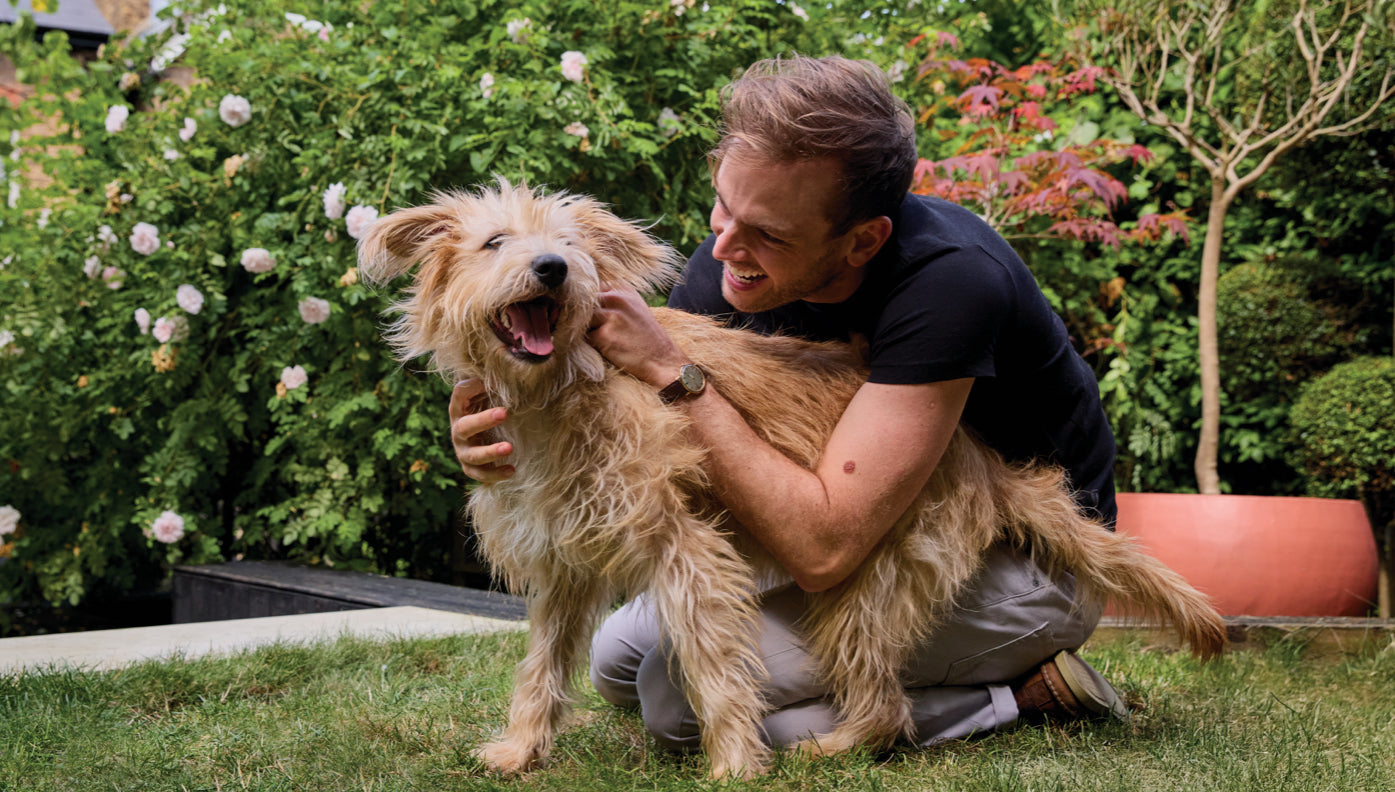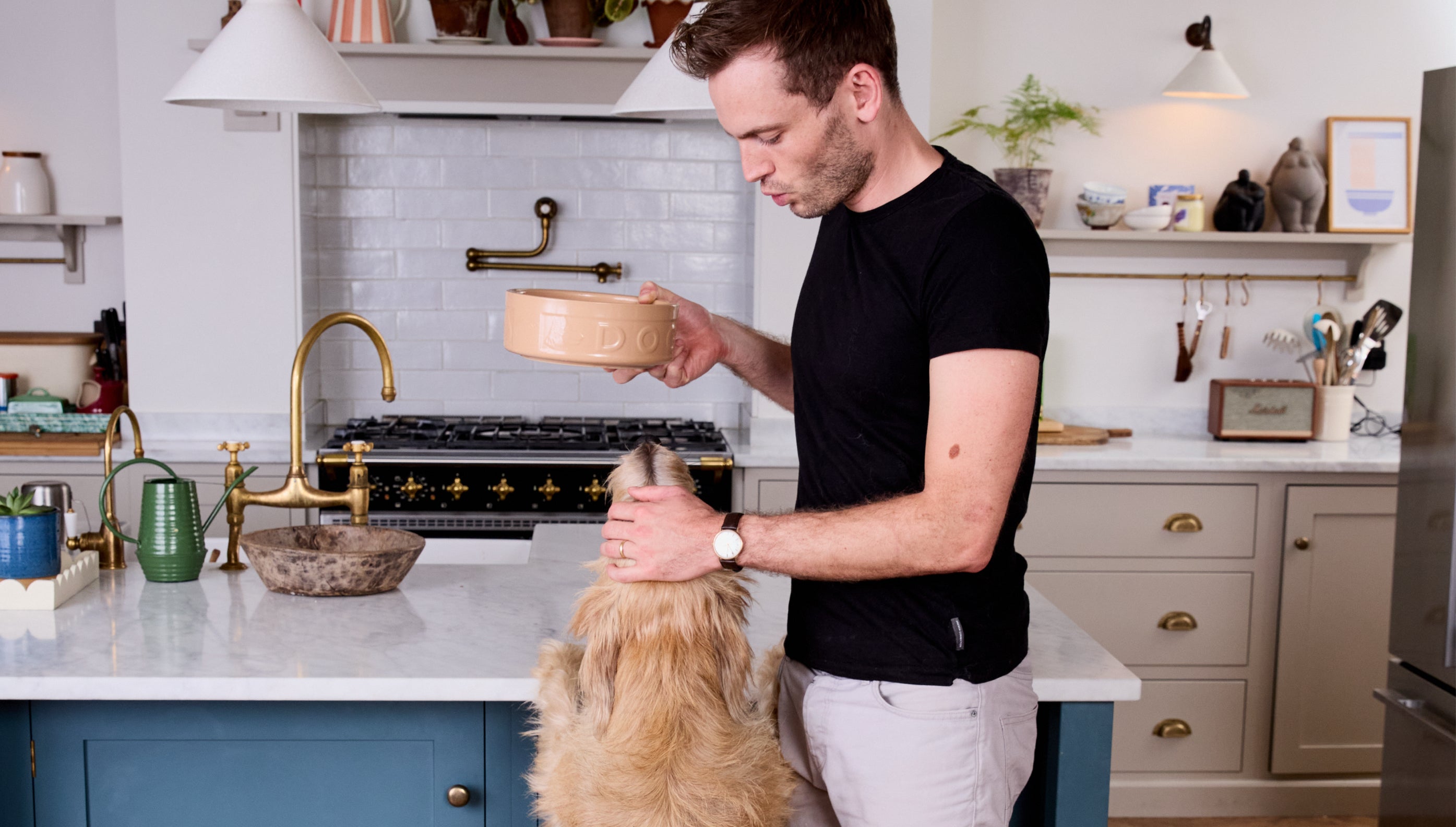Hay fever, also known as ’allergic rhinitis’, is an allergen driven inflammatory condition of the nose caused by pollen, dust and mould. Sufferers will know that pollen levels are at their highest around summer and spring. But what about our pets? Can dogs get hay fever? The answer is yes! Animals can also suffer from hay fever. Furry friends, we feel your pain.
Rory the Vet shares his dog parent guidance on pooch hay fever, including how to spot symptoms and how to treat.
MEET RORY THE VET

Starting with his degree from the Royal Veterinary College, Rory has since co-starred in the CBBC’s series The Pet Factor, shared his knowledge on the likes of Blue Peter and written all about it in his book, Secret Life of a Vet.
Follow him on Instagram
Can dogs get hay fever?
Yes, dogs can get hay fever. For humans, this condition is characterised by puffy, red and itchy eyes, a runny nose, sneezing and general malaise. While dogs can display all of these signs too, there are also differing symptoms, and these can all vary in severity. More on that later.
Causes of hay fever in dogs
Hay fever is caused by the nose and eyes reacting with a pollen allergen that is released from grasses, weeds and trees. These allergens vary in their prevalence at different times of the year. We see most cases of hay fever affecting sufferers around spring and summer, but I have seen a few cases where dogs have experienced symptoms in winter and autumn.
Note that your dog may be allergic to something else, such as fleas or dust mites, so it‘s a good idea to get your pooch checked over by your vet to properly diagnose the issue.

Hay fever symptoms
Dog hay fever symptoms include the following:
• Excessive scratching: If your dog begins itching their face or body excessively, especially after a walk, this could be a reaction to pollen
• Sneezing: This is caused by the allergens irritating the nose and pharynx
• Reverse sneezing: (Or inward sneezing.) Often seen in smaller dogs
• Runny eyes
• Hives & skin swellings: These are the more extreme symptoms we may see from a severe allergic reaction
• Sore feet: Your dog’s feet are in contact with grass more than any other part of their body, and so foot chewing can be a common sign of an allergy
How to treat hay fever in dogs
Although hay fever can’t be cured, there are ways you can help your dog manage their symptoms. Before you start looking into dog hay fever treatment, you need to consult with your vet first. Your veterinarian can discuss possible medications that may be suitable for your dog. There are a few options, including antihistamines, which may help during mild cases, whereas Apoquel, Cytopoint and steroids are more commonly used to help severe cases of hay fever.
Besides medication, here are a few home remedies you can do to help relieve your dog‘s suffering.

Walk your dog when the pollen is low
The pollen count is lower at certain times of the day. I would suggest walking your little friend either early in the morning or later in the evening. The pollen count is highest at midday. If you notice that your dog’s symptoms flare up after a specific route, avoid heading that way until the season has changed. Always check the pollen forecast ahead of time.
Keep your dog on a lead when necessary
Controlling where your dog goes can help prevent them from exposing themselves to high levels of pollens, for instance, in long grass, farmland or planted areas.

Keep their fur clean
Bathing and removing allergens from your dog’s coat can help prevent allergenic inflammation. While your furry friend is suffering from hay fever, try bathing them more often than usual with soothing, dog-approved shampoos, and wipe their feet with a damp cloth when they come in from a walk to remove excess pollen.
Relieve itchy skin with a cool compress
Cold therapy, i.e. compresses, can help areas of inflammation. Just make sure you don’t get water down your dog’s ears as this runs the risk of an ear infection.
Keep your dog’s bedding clean
Regularly washing and vacuuming your dog’s bedding on a weekly basis will help remove any pollen they have collected from trips outside. Better yet, I would recommend hoovering and wiping surfaces all over your house. Allergens can develop inside the home, and they can also come in through the window or via your shoes.

Common questions about hay fever in dogs
Rory the Vet answers the most searched queries on dog hay fever.
Can I give my dog antihistamines?
Only if your vet has given you the go-ahead!
Can my dog get an allergy test at the vets?
Yes! This can be useful to identify exactly what is causing your pet’s allergies. It can even be used to develop an allergen specific vaccine.
If my dog has hay fever, should I take them to the vet?
If your dog is showing signs of an allergen, it’s important to get them checked over by your vet to properly diagnose the issue and make sure there are no other underlying concerns.

Are certain dog breeds more prone to hay fever?
Smaller breeds are more susceptible to hay fever than others because they are lower to the ground, and therefore more exposed to pollen. Anecdotally, white and blue pigment dogs are often more prone to suffering from skin allergies.
Can puppies get hay fever?
Rarely. Puppies can exhibit signs of hay fever, but this is usually a response to new allergens as they explore the world for the first time.
Are there any foods I can give my dog to help with hay fever symptoms?
Foods high in omegas can help with skin health. I often advise dog parents to feed their dogs fish-based foods as these can support the skin barrier.
For dogs with itchy and sensitive skin not affected by hay fever, look to these recipes which have been specially formulated to help.
The information in this article is intended as a guide to help pets and pet parents on their journey together. It is provided for educational and informational purposes only and is not meant as a substitute for professional advice from a vet, behaviourist, trainer or other professional. We encourage all pet parents to consult with their vet and/or behaviourist to ensure their pet’s specific needs are met.
Published on 07/02/2025




